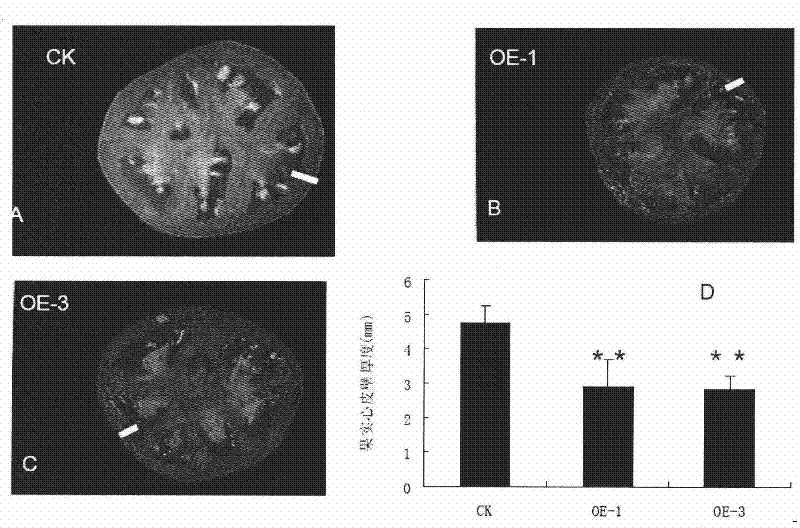Proteins regulating fruit and seed development and their applications
A fruit and seed technology, applied in the fields of biotechnology and botany, can solve the problems of low efficiency, few, long breeding time, etc.
- Summary
- Abstract
- Description
- Claims
- Application Information
AI Technical Summary
Problems solved by technology
Method used
Image
Examples
Embodiment approach
[0077] As an embodiment of the present invention, the gene encoding the ENS protein is cloned into an appropriate vector by conventional methods, and the recombinant vector with the foreign gene is introduced into the plant cells that can express the ENS protein , making the plant cell express ENS protein. Plants (over)expressing ENS proteins can be obtained by regenerating said plant cells into plants.
[0078] Preferably, a method for preparing transgenic plants is provided, comprising:
[0079] (1) transferring the gene encoding the exogenous ENS protein into plant cells, tissues, organs or tissues, and obtaining plant cells, tissues, organs or seeds transformed into the gene encoding the ENS protein; and
[0080] (2) Regenerating the plant cells, tissues, organs or seeds obtained in step (1) into which the gene encoding the exogenous ENS protein is regenerated into plant plants.
[0081] As a preferred example, the method comprises the steps of:
[0082] (s1) providing ...
Embodiment 1
[0095] Embodiment 1, plant material and growth condition
[0096] Arabidopsis wild-type Columbia-0 seeds were purchased from the American ABRC Center. Tomato VF36 seeds are provided by Institute of Plant Sciences, Shanghai Academy of Biological Sciences, Chinese Academy of Sciences (or refer to "Plant Tissue Culture Manual", the article "Transformation of tomato with Agrobacterium tumefaciens" (SHEILA McCORMICK Transformation of tomato with Agrobacterium tumefaciens.Plant Tissue Culture Manual, 1991, 1991, published in 1991, B6: 1-9)). Arabidopsis plants were grown in an artificial greenhouse at 21°C with 16 hours of light and 8 hours of darkness. The tomato plants were grown in an artificial greenhouse (day temperature 22-26° C., night temperature 15-20° C.) with 12 hours of light and 12 hours of darkness.
Embodiment 2
[0097] Embodiment 2, the cloning of Arabidopsis ENS gene
[0098] (1) Isolation of RNA
[0099] Take Arabidopsis leaf tissue, grind it with liquid nitrogen, put it into a 1.5ml centrifuge tube, add 1ml Trizol, shake it well, add 1 / 5 volume of chloroform, mix it upside down, let it stand at room temperature for 5 minutes, centrifuge at 12000rpm for 5 minutes, and take it out. Clear, add an equal volume of isopropanol and mix well, place at room temperature for 5 minutes, centrifuge at 12000rpm for 5 minutes, discard the supernatant, add pre-cooled 75% ethanol, centrifuge at 7500rpm for 5min, discard the supernatant, air dry for 5-10min, dissolve in DEPC water. The quality of total RNA was detected by agarose gel electrophoresis, and then the RNA content was determined on a spectrophotometer.
[0100] (2) RT-PCR
[0101] Using Arabidopsis total RNA as a template, TOYOBO reverse transcription reagent (ReverTra Ace) was used to synthesize the first strand of cDNA, and the rever...
PUM
 Login to View More
Login to View More Abstract
Description
Claims
Application Information
 Login to View More
Login to View More - R&D
- Intellectual Property
- Life Sciences
- Materials
- Tech Scout
- Unparalleled Data Quality
- Higher Quality Content
- 60% Fewer Hallucinations
Browse by: Latest US Patents, China's latest patents, Technical Efficacy Thesaurus, Application Domain, Technology Topic, Popular Technical Reports.
© 2025 PatSnap. All rights reserved.Legal|Privacy policy|Modern Slavery Act Transparency Statement|Sitemap|About US| Contact US: help@patsnap.com



